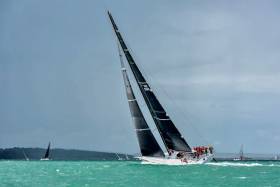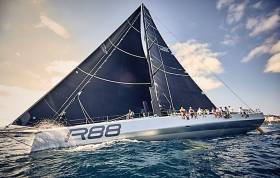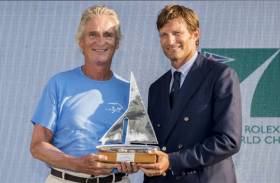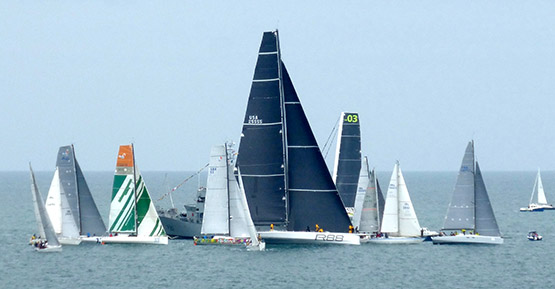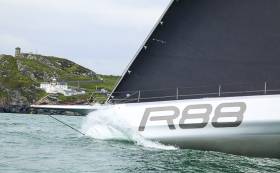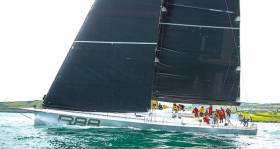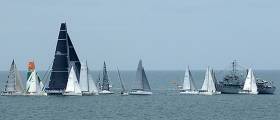Displaying items by tag: Rambler 88
While the main kudos in the Rolex Fastnet Race comes from class wins or ultimately the Fastnet Challenge Cup for the overall IRC winner, who will simply be first home to Plymouth often turns into an engaging, heavyweight bout.
Among the monohull contenders this year, in one corner is the Hong Kong newcomer, Seng Huang Lee’s 100ft Scallywag, skippered by Australian David Witt with a crew featuring many of the sailors from their Volvo Ocean Race campaign.
In the other is George David’s familiar Juan K-designed Rambler 88, a boat that has been tweaked to within an inch of its life by its fastidious crew including many former Team New Zealand America’s Cup heroes.
For Scallywag, the Rolex Fastnet Race will be one of the pinnacles amid a major trophy-hunting season that kicks off in the Caribbean at Antigua Sailing Week and follows with the Antigua Bermuda Race, and then the historic Transatlantic Race 2019 from Newport, RI to Cowes via the Lizard. Post-Fastnet, Scallywag heads for the Med.
Part of Scallywag has enjoyed previous success in the Rolex Fastnet Race – her foredeck and some of her frames come from Charles St Clair Brown and Bill Buckley’s Maximus, line honours winner in 2005.
However, she was launched brand new for the 2014 Rolex Sydney Hobart as Ragamuffin 100 for Australian sailing legend Syd Fischer, who contributed to her design with Witt and naval architect Andy Dovell.
According to Witt, Scallywag — with a beam of 5.8m — falls between the slender multiple Hobart winner Wild Oats XI (5.1m beam) and the powerful Comanche (8m beam), the 2015 Rolex Fastnet Race line honours victor.
“We are the lightest 100 footer with the most sail area,” says Witt. The boat has a keel that cants to plus or minus 45 degrees, twin daggerboards and starts the season with a new boom.
Seng Huang Lee will be on board for the Rolex Fastnet Race. “His main goal with this boat is to win as many Rolex events as he can this year with the main emphasis being the Rolex Fastnet Race and the Rolex Sydney Hobart,” explains Witt, who personally has sailed the Fastnet many times including on the Grand Mistral/Maxi One Designs, Nicorette and on Knut Frostad’s VO70 Innovation Kvaerner.
Witt says he finds the Fastnet Race more challenging tactically than the annual race to Hobart: “It is around a rock, so it gives the chance to sail the boat in a different range of conditions. The Hobart race has been mostly straight downwind in recent editions.”
As to how they will get on against Rambler 88, the last time the two boats met in the 2015 Rolex Sydney Hobart, it was close: the longer Scallywag (then Ragamuffin 100) gained the upper hand at the finish line to win by just over four minutes.
“I’d hope we’re faster, but you never know,” says Witt. “We have only raced Rambler 88 once before and we got the better of them. But it’ll depend on far we have both come with our development.”
 George David’s Juan K-designed Rambler 88
George David’s Juan K-designed Rambler 88
One of the Rolex Fastnet Race’s most faithful combinations, George David and Rambler 88, returns for a fifth time in the hope of achieving a result they deserve finally.
As David states: “Too often we have been bridesmaid, which could be what brings us back along with the great traditions and scenery of this classic race.”
And this is despite David coming close to losing his life when in 2011 his Rambler 100 lost its keel and capsized after rounding the Fastnet Rock, leaving him in the water drifting away from the boat.
In that race David says they were on track to break the record, which ultimately went to the Ian Walker-skippered VO70, Abu Dhabi Ocean Racing, with a time of 1d 18h 39m 00s — the present monohull race record — while Mike Slade’s ICAP Leopard set the Maxi record of 1d 20h 09m 47s.
Recent races’ conditions haven’t favoured big boats on handicap. In 2003 Charles Dunstone came close to claiming ‘the double’ (ie line and handicap honours) with his Reichel Pugh 76 Nokia but was beaten across the line by Neville Crichton's Alfa Romeo 1. The last boat to score the double was Ludde Ingvall and his Maxi Nicorette in 1995.
Even rarer are the ‘triples’ — line and handicap honours plus the race record. Wild Oats XI managed it twice (2005 and 2012) in the Rolex Sydney Hobart and George David and Rambler have also enjoyed it in other races, notably the Rolex Middle Sea Race in 2007 (with a record that still stands), the 2016 Volvo Round Ireland Race and in last year’s RORC Caribbean 600.
“This has to be the goal for us in this year’s Rolex Fastnet although – as always – the weather needs to co-operate,” states David. “Big breeze should give us the edge against Scallywag and conversely lighter breeze won’t.”
This is the assessment too of Rambler 88’s eminent tactician Brad Butterworth: “Scallywag is a pretty fast boat – it has got a lot of sail area and a lot of stability. If it is a predominantly light to moderate air race it will be difficult to keep up with those guys, but if the breeze gets up and it gets sporty, we’ll have a chance. In 18 knots or more, we start to perform much the same as them.”
Rambler 88 goes into its fourth season highly refined, benefitting from several keel modifications and an ever-evolving sail wardrobe. “It has got better and better. Now it is going to its maximum,” states Butterworth. New for this season is a slightly lighter mast and a deeper keel.
And while this might seem to be a match race, a possible re-enactment of Rambler 88’s battle with Comanche in 2015, there are still other prospects. If conditions are brisk, how far behind them would a foiling IMOCA 60 like Jérémie Beyou’s Charal be?
For more details visit the Rolex Fastnet Race website HERE.
There's Life in IRC Yet as Rambler 88 Takes RORC Channel Race - With Sights Now Set On Fastnet
#Rambler88 - Last weekend’s RORC Channel Race has clearly demonstrated two things writes W M Nixon. Firstly, the way that George David’s hugely impressive Rambler 88 won the Volvo Round Ireland race 2016 every which way was no flash in the pan. Until Rambler 88 came along, line honours and the Corrected Time overall win were thought well-nigh impossible of achievement. Yet now the big silver bullet has done it in Wicklow’s Round Ireland, in the RORC’s Cowes-Dinard/St Malo race, and now she’s done it yet again in the RORC Channel Race.
The second Big Thing which has been demonstrated is that in RORC racing, the IRC is working mighty well. On Corrected Time, Rambler 88 was first, Piet Vroon’s Ker 51 Tonnere 4 was second, and the French two-handed JPK 10.10 Night & Day (Pascal Loison) was third. Night & Day incidentally also won out in the 2013 Rolex Fastnet Race in the same two-handed configuration, so she’s some boat and some crew. But as we read on through tho official report, what emerges most obviously is the incredible spread of successful boats, and the tiny time margins between them. There’s life in the IRC yet……
Days after winning the King Edward VII Cup in this year’s Cowes-Dinard-St Malo Race, David’s Rambler 88 has made it two in a row with victory in the 2017 RORC Channel Race.
The American Maxi took line honours and was the overall winner in the 160nm, 109-boat race at the weekend — the last stage in the RORC Season's Points Championship before the Rolex Fastnet Race from Sunday 6 August.
“We wanted to race in good breeze, and we certainly got that in this race,” said Rambler 88’s project manager Mick Harvey, who added that the race around the Isle of Wight “has been a good build up to the Fastnet, which is the big event for us.”
Former Fastnet podium finishers have shared their secrets for success in the world’s biggest offshore race, as previously reported on Afloat.ies previously reported on Afloat.ie.
Rambler 88 Wins Cowes-Dinard-St Malo Race
#Rambler88 - George David’s Rambler 88 has won the King Edward VII Cup in this year’s Cowes-Dinard-St Malo Race.
The American Maxi took line honours in the 151-nautical-mile offshore race and was also declared overall winner IRC time correction of the 176-boat fleet, which sailed from for Brittany from Cowes on the Isle of Wight last Friday (7 July).
The Cowes-Dinard-St Malo Race is the ninth stage of the 14-race RORC Season’s Points Championship, currently led by defending champion Lisa, the Beneteau First 44.7 owned by Nick and Suzi Jones and sailed by RORC Commodore Michael Boyd.
Earlier this year, Rambler 88 — which had a record-breaking debut in last year’s Round Ireland, years after a memorable capsize in the 2011 Fastnet Race — took line honours in a cliffhanger finish at the RORC Caribbean 600, as previously reported on Afloat.ie.
The RORC Caribbean 600 began with a cliffhanger start involving real cliffs from which the Maxi 72 Bella Mente (Hap Fauth, US) got the better of defending champion Proteus, another American Maxi 72 campaigned by George Sakellaris and Reginald Cole writes W M Nixon.
And as of 1800hrs Irish time Wednesday, with just thirty miles to the finish at Antigua, it’s likely they’re racing for the overall win in a cliffhanger finish, metaphorically speaking this time, swapping places with every manoeuvre.
The way that this unique race of a cat’s cradle course around and among islands to make up a total distance above the magic minimum 600 miles expected of the great classics may mean that it’s not really offshore racing as we usually know it. But it certainly has its followers on the edge of their seats.
Rambler 88 is currently the only boat finished, and predictions based on current performance suggest she might hold onto fourth. But with afternoon breezes building and then falling away as the rest of the fleet make their way towards the finish off English Harbour, the very fact of having it done and dusted is a matter of quiet encouragement for George David and his crew aboard the boat which won every which way in the Volvo Round Ireland Race just eight months ago.
Meanwhile, think of the mental stress. Even while we’ve been scribbling this, Ian Moore’s tactics have brought Bella Menta up past Proteus, and the Fauth boat is now three miles ahead of Proteus with just 29 miles to go, and making 9.6 knots to the 5.8 of Proteus……Time for a cup of strong tea.
RORC Adds: George David's American Maxi, Rambler 88 finished the 2017 RORC Caribbean 600 on Wednesday 22 February 2017 at 11 hrs 56 mins 17 secs AST taking Monohull Line Honours.
This year was George David's third line honours win in the RORC Caribbean 600. However, the record set by his previous boat, Rambler 100 in 2011 remains intact for another year. However, George David was very content with the performance of the team and Rambler 88.
"The forecast was right on for direction as the breeze went a full 360 degrees, but we had a bit more velocity than anticipated. It was a good race and we enjoyed it very much but this was a different race altogether. It was more like the English Channel than the Caribbean and Rambler 88 will be racing there this summer in our build up to the Rolex Fastnet Race. I have never taken part in those races before so that will be interesting as well.
Mike Slade's British Maxi Leopard 3 is expected to be the second monohull to finish the race in front of two Maxi72s vying for the overall win under IRC: Hap Fauth's Bella Mente and George Sakellaris' Proteus. Lionel Pean's French Volvo70 SFS II is also expected to finish the race today, 22 February at 17:30 AST.
Record–Breaking Rambler 88 Does it Again
George David's super-maxi Rambler 88, overall winner and record breaker in the Volvo Round Ireland race 2016 back in June, has added a new accolade to her already enviable sailing reputation as she crossed ARC Finish Line in Rodney Bay, Saint Lucia 15:14:15 local time (19:14:15 UTC) on Monday 28 November to break the ARC Course Record. Departing Las Palmas de Gran Canaria at 12:45 on 20 November alongside over 200 boats in this year's Atlantic Rally for Cruisers (ARC), the Juan K. designed cutting edge racer has been pushed to her limit by an impressive professional crew of sailing legends. Fellow boats in the ARC Racing Division, including many of the previous record holders sailing on board VO70 Trifork, were left in their wake; even light winds were not going to stop Rambler's mission to claim the record.
The new course record now stands at 8d 6h 29m 15s beating the previous time by 1h 10 minutes and 15 seconds. In 2015, Team Brunel sailed 3343.3nm based on the YB track at an average speed of 16.8 knots. Winds have been lighter than last year, however Rambler 88 took advantage of a small depression which formed mid-Atlantic soon after the start, enabling the boat to sail a very northerly route and then have a fast reach down to Saint Lucia. Overall, they have sailed approximately 270nm less than Team Brunel, which has been a crucial factor for this year's lighter wind crossing.
This is the fourth consecutive year that the Course Record has been beaten; a year ago VO65 Team Brunel claimed the title from Farr 100 Leopard by Finland. Mike Slade's super-maxi had taken over two days off the previous record set by Caro, a Knierim 65 in 2013. A growing tradition of sleek, high-tech racing yachts joining the ARC seems to have developed, with the rally offering a different environment to sail these impressive machines from the pro-racing circuits. This was the first time sailing in the ARC for Rambler 88, and before setting off from Las Palmas de Gran Canaria Project Manager Mick Harvey commented, "It's been a really good experience dealing with the organisers of the ARC. Everyone is very helpful and it's quite an eye-opener for someone coming from the racing side, which can be quite combative. George David, Rambler 88's owner, really wanted to join in with the ARC because he enjoys transatlantic crossings and scheduling-wise, this worked well."
Harvey played down the expectation that breaking the record was a foregone conclusion when Rambler 88 set off from Gran Canaria, "I think every time we go out there with this boat there's an opportunity to break the record, but the conditions at the start of this race didn't look like they were going to be indicative of breaking the record at all. In Las Palmas, the fastest it looked was maybe 8 days, maybe, and it could easily have been as long as 9 or 10 days. Luckily they managed to hook into a couple of good systems initially and then they were off and running."
Reaching the dock, Rambler's owner George David echoed that the main challenge this year was the weather and the lack of wind has kept the crew guessing to the final hours, "Once we set off, we were confident we could make the crossing in 8 days, but the record was less certain, right up until we crossed the finish line really. Two squalls came across us in the morning bringing torrential downpours but no wind so that slowed us down even more. Given the challenges this year, we are thrilled to have broken the record!"
Arriving in Saint Lucia, Rambler 88 received a fitting welcome. Not only did they break the course record, but they are also the first yacht sailing under the ARC banner to reach Rodney Bay in 2016. Usually, boats from the ARC+ Cape Verde fleet have begun to make landfall, but the low pressure system haunting the rhumb line this year has slowed their progress. Sailing from Mindelo in the Cape Verde, they have a shorter distance of 2090nm for the second leg of their Atlantic crossing, and departed on Wednesday 16 November, four days ahead of the ARC boats sailing 2,7000nm directly from Gran Canaria. It's a testament to Rambler's navigation and tactics that they have lead the advent of ARC yachts into Saint Lucia and the Rally Control team together with Saint Lucia Tourist Board and staff of Rodney Bay Marina are looking forward to welcoming the rest bumper fleet in the coming days and weeks
British Yacht Leopard 3 Wins at Maxi Yacht Rolex Cup
Mike Slade's Leopard 3 won the prestigious Maxi Racing Class at the 27th edition of the Maxi Yacht Rolex Cup in Porto Cervo, Italy today.
After a fascinating duel between Mike Slade's British Maxi Leopard 3 and Round Ireland monohull record holder George David's American Maxi Rambler 88, the winner of the biggest prize in Maxi Racing, hung on the very last race. During the 30-mile decider, the two high-performance yachts were locked in an intense battle, never more than a few boat length apart. At the finish line, Mike Slade's Farr 100 Leopard 3 was just seconds ahead of George David's Rambler 88, to claim one of the biggest prizes in the sport.
“Early this year, Leopard had a major refit, including adding more sail power, that combined with winning every start at the regatta was the key to our success. Huge thanks to the the crew and Skipper, Chris Sherlock, for all the long hours put in to turn Leopard into a world beater. I am on cloud nine, winning at the Maxis is a wonderful achievement.” commented Mike Slade.
Mike Slade's Leopard 3 will be back in action at Les Voiles de St Tropez from the 24th September, before competing in the 3000-mile RORC Transatlantic Race in November, with a full Caribbean season to follow.
At 704 miles long, with a course along coastlines of almost infinite variety, the Round Ireland Race was always a complex event for post-race analysis even when fleets amounted to only three dozen or so. But for 2016 in the first year of sponsorship by Volvo Car Ireland, the number of starters soared to 63. And the inclusion of multi-hulls for the first time since the initial pre-RORC race of 1980 added further depth to the eclectic nature of the fleet, which was already an extensive array, as it ranged from small craft like a J/97, a First 31.7 and a Sunfast 3200, to one of the current superstars of world sailing, George David’s Juan K-designed canting-keeled Rambler 88. Having provided us with 17 up-dates during the six days of the race, W M Nixon takes a final overview.
Here’s to Yellowbrick, the friend of armchair sailors everywhere. In the old days, trying to analyse or explain the unfolding story of the biennial Round Ireland Race was a formidable challenge. And you could be talking about it to people very few of whom had ever sailed round Ireland, while others didn’t even know it from the land, as they have been availing of sunshine holidays ever since cheap air travel arrived.
Thus there are many who know more of the coasts of Spain, Portugal and Greece – or even the Scottish Hebrides and the Isles of Scilly - than they do of Mayo and Donegal. And having experienced both those Irish counties in their more perverse meteorological moods in the course of several races round Ireland - not to mention many non-racing cruising circuits – I have to admit that I can see their point of view.
The Yellowbrick tracker for the Volvo Round Ireland Race 2016 wraps Ireland in its web. TriLogic went furthest east after the start, the three MOD 70s went furthest south off the south coast and furthest west off the west coast, Rambler 88 went furthest northwest, and Pegasus of Northumberland went to the Isle of Man but came back to cross tacks yet again with Teasing Machine, this time at Skerries as the Machine came south from Dundalk Bay.
"Round Ireland 2016 is in a special league of its own"
Yet the round Ireland race is addictive, and for those who have done it in the past, particularly those who have done it several times, it’s a bit of a pang to see the fleet go off and not be part of it. Even with all the modern equipment and boats which are obviously faster, it’s still a very worthy challenge. And it induces a special post-race camaraderie among crews who, in racing terms, have been at each other’s throats since the start.
After each biennial staging, something new has always turned up to add to the sailing history books. But the Volvo Round Ireland Race 2016 is in a special league of its own in this category, so much so that far from just adding something to the history books, it probably deserves a book of its own.
In fact, you could write a book about the fantastic start in which Rambler 88 gave a Masterclass in discerning emerging gaps beginning to appear in a melee of sometimes confused smaller bats. Despite her huge beam she came cleanly through to a peach of a start right on the committee vessel LE Aisling, bettered only by Eric de Turckheim’s A13 Teasing Machine while smaller craft which thought they’d done better found they’d been OCS, which led to a slow and painful return against a strengthening ebb to re-start.
Rambler’s miraculous start, finding gaps where none had existed ten seconds earlier. Photo: W M Nixon
Fortunately in making some sense of what happened afterwards, we can take a precise positional overview by looking at the Yellowbrick tracking as it was at virtual completion yesterday afternoon. It may look like a right cat’s cradle of lines all eventually getting back to Wicklow, but there are stories to be drawn from every part of it.
In the first beat from Wicklow Head down to the Tuskar Rock, very few boats tended to the east, and it certainly didn’t pay off. The one who went furthest east was the 50ft Trilogic, Hugo Carlsson-Smythe’s trimaran, which ultimately retired during the course of the race with gear and sail problem, so we don’t know if ultimately she would have overcome this initial tactical error.
The mono-hull which tacked furthest east was Chris & Patanne Power Smith’s J/122 Aurelia (RStGYC), but she then put in a good showing in the long beat along the south coast and got herself back in the hunt, although off the north and east coasts things didn’t go quite so well, but in the end she placed 3rd in IRC 2 and 18th in IRC overall.
"Teasing Machine made a proper job of tide-dodging"
While the bulk of the fleet were still struggling against foul tides down the Wexford coast with Teasing Machine showing how to make a proper job of tide-dodging inside the Wexford banks, out ahead the biggies were splitting into their two parts of this fleet of four parts.
Although the reckoning was that conditions might just fall the right way for a new record, the three MOD 70s first had to find a breeze to raise them above the 12 knots which they occasionally fell back to as they came on starboard out past the Coningbeg Light. Thus it’s Musandam-Oman, Phaedo and Concise which are those three tracks which go way to the south. As they were so close to each other in performance, they sailed as a pack, so there was an element of covering as much as strategy in this, but in these early stages it was Ned Colllier Wakefield aboard Concise who was making the pace, with Phaedo next in line, while Musandam seemed to find it difficult to obtain quite the same speed.

The first hint of light in the east in the sky as the MOD 70 Musandam-Oman closes in on the Wicklow finish for a last-minute takeover of the line honours lead on the water, after her sister-ship Team Concise had led for most of the race. Photo: Mark Lloyd
Perhaps Irish sailing superstar Damian Foxall aboard Musadnam was slightly over-awed by it all, as he hadn’t been aboard Musandam when she set the new open Round Ireland record back in May 2015, and in an interview before the race (see below), he revealed that he and Justin Slattery – who was on Lloyd Thornburg’s Phaedo - were both Round Ireland virgins. They’ve been so busy building their international careers in other parts of the world that racing round their home island had never come up on the radar.
Whatever the reason, it was Concise which was least fazed by the challenge, she stayed closely in the lead, and after they’d tacked and started ripping up the west coast in the rising sou’west winds of Sunday, it was Concise which recorded the MOD 70’s best speed of 41.56 knots. But as they admitted afterwards, they weren’t right on the edge when they his that mega-speed in a growing Atlantic swell – they were beyond it.

Just outside a two day elapsed time, George David's Rambler looked every inch a winner in her debut Round Ireland race. Photo: Afloat.ie
After her glorious start ten minutes ahead of the MOD 70s, Rambler was going so well in the moderate southerly that she was past Arklow before the trimarans came through, but soon they’d disappeared ahead, and thus for the reminder of the race Rambler 88 was entirely on her own, thereby providing Part 2 of our four part round Ireland fleet. Although she’d been holding the IRC overall lead for a while, at various stages she’d dropped back as smaller craft got clear of foul tides. But once she was past the Fastnet and beginning to build her speed up the west coast in rising breezes, she was soon featuring among the front runners on all counts.
If anything, the weather felt almost Autumnal off the west coast, it had seemed slightly spring-like as warmer weather spread in while the leading big boats were far at sea seeking breezes off the south coast, and there was decent sunshine while the larger boats of the fleet were shuttling from Dun Laoghaire down to Wicklow on the Saturday morning for the start. But on the Thursday night in Dun Laoghaire when it was open house at the Royal Irish YC to meet the heavy hitters, a local weather anomaly was giving a temperature of 9 degrees Celsius which had been winter by anyone’s standards, it was certainly experienced but fortunately it wasn’t to occur again.
With the leading big boats zapping up the west coast on Sunday as south to sou’west winds continued to freshen, records were once again top of the agenda. But this was all of academic interest to the main part of the fleet bashing its way along the south coast, for as Sunday went on, conditions became increasingly rugged. Yet it was not without its local oddities – for a period on Sunday afternoon, there was very little wind indeed in an area close in on the entrance to Cork Harbour, and the spread of breeze was so uneven that the tracker revealed some boats taking rather desperate gambles to try and find steadier conditions.

Mark Mansfield and Maurice “The Prof” O’Connell on Dave Cullen's J109 Euro Car Parks, the IRC3 winners. Photo: Afloat.ie
One boat which did notably well during this stage was Dave Cullen’s J/109 Euro Car Parks. With Corkmen Mark Mansfield and Maurice “The Prof” O’Connell calling the shots, they gave a masterful demonstration of how to work the bays slugging west beyond the Old Head of Kinsale.
“Working the bays” doesn’t necessarily always pay off, and in fact it didn’t work so well for other boats near Euro Car Parks. So clearly an important factor in the successful use of this ploy is to have a boat which is out-sailing everyone else in any case, and it was noticeable by this stage that Euro Car Parks had worked out a formidable lead on all the other J/109s while she herself was in hot pursuit of Paul O’Higgins new JPK 10.80 Rockabill VI, racing with the noted talents of Mark Pettit and Brian Mathews on board.
"Rockabill VI was a very slippy performer"
As Sunday evening and night went on, the Fastnet became increasingly difficult to get past as the area of steadier fresher breeze moved to the north. Thus while bigger boats such as Alan Hannon’s Reichel-Pugh 45 was making hay up past the Blaskets with a performance which suggested that she a going better and better as her Lough Swilly YC crew became accustomed to her ways, back down the line off the mouths of the great rias of the southwest at times the wind was all over the place, and Euro Car Parks was one which suffered, head off south of Dursey Dound, and forced to tack seaward in unspeakably lumpy sailing conditions.
By this time Rockabill VI was showing she was a very slippy performer, and the long run up the west coast was brilliantly sailed by her talented crew, so much so that by Tory Island she’d opened out a lead of 40 miles on Euro Car Parks, which looked unassailable.
But for others even thinking about Tory Island was still way off the radar, as many boats reckoned they’d taken a ferocious battering through the latter part of Sunday, and there were retirals at all levels of the fleet. Meanwhile away to the east the oldest boat in the race, Darryl Hughes’s 1937 Tyrell of Arklow 43ft–gaff ketch Maybird was making only very slow progress and she’d sustained damage aloft and to sails, so she went into Dunmore East and kept the crew strictly on board and out of contact with the shore while they made repairs and then, most gallantly, they put to sea again and eventually after another two days of slow progress to windward they had the freeing of sheets at Mizen Head within sight, but then it was discovered that there was a major problem with the engine, so they retired regretfully into Baltimore.
By this time the great dramas of the record finishes at Wicklow had been played out through Monday. So long as there’s breeze your ordinary North Channel fair or foul tides aren’t the major consideration for he MOD 70s, it’s the presence of wind which is the primary consideration.
Sunday evening found the MOD 70s shaping themselves into the North Channel and fetching through with all still close together and Concise still just leading, but from the South Rock on it was hard on the wind or beating to get to Wicklow. Musandam was still trailing the other two, so she took a brief slant towards Dundalk Bay and then went on to starboard to pace with them about two mioles further westward, bringing her in closer to Howth than Concise or Phaedo, and putting her in a better breeze as the wind started to play tricks in the dark of the small hours off Bray.
Everything was gettingly nail-bitingly tense, and south of Greystones, Phaedo and Concise were slowing markedly, so Musandam came up from astern and took a bit of an offing, finding better breeze only a short distance offshore which carried her right to the line at Wicklow to finish ahead and created an absurd new record of 1 day 14 hours and 37 minutes, with Phaedo 3 six minutes astern, and Concise – which had so gallantly led for most of the race – coming in another minute later.
Follow that, as they say, but somehow Rambler 88 managed to outdo the drama, as she did the final stage from Rathlin Island to Wicklow in just part of the one span of daylight on Monday. But by the time she came calling the wind had veered and thus she was able to lay the whole way down the Irish Sea to the finish, and was travelling at full chat as she came into the line.
While a mono-hull record within two days was no longer possible as she’d sailed 790 miles in all thanks to that long tack to the south in search of better breeze through Saturday night and Sunday morning, nevertheless she still made an almighty dent in every other mono-hull record by finishing in a time of 2 days 2 hours 24 minute and 9 seconds.
There was still some bite to the winds, but even in a poor summer such as we’re currently experiencing, the fact that the sou’west to west breeze had now been blowing moderate to strong and more for more than three days was increasing the likelihood of calm patches, and a general falling away in wind strength.
So gradually the crazy notion took hold that not only would the popular Rambler 88 be lauded as the new all-out mono-hull record holder, but she might even manage to win the race on corrected time. Certainly the holes in the wind now began to appear with increasing frequency, and none more so than for Rockabill VI as she rounded Inishtrahull, the most northerly point of the course, on Tuesday.

Rockabill VI – a new JPK 10.80 design. Photo: Afloat.ie
The O’Higgins crew came up against what was soon known as the Great Glass Wall of Inishtrahull. Rockabill and the three other boats in her immediate neighbourhood all came to such a complete halt that tracker-followers assumed they must all have fouled lobster pots. But they were simply and totally becalmed. They made no progress for three hours, yet boats close to the east were still bustling busily towards Rathlin Island, while boats close to the west were trundling merrily in from Tory.
So after the episodes of winter and spring and autumn, Rockabill was experiencing a brief bit of summer she could have well done without. Finally she got going again, but by this time Euro Car Parks had sliced a huge 20 miles out of Rockabill’s 40 mile lead, and thereafter it was Euro Car Parks ahead in IRC 3 on corrected time. In other classes, solid performances and reliability in strong winds had been rewarded, and in IR2 the beautifully-prepared Cornish-based Swan 47 Sarabande (Rob Mabley) had a lead she held to the finish, while in IRC 4 we were witnessing one of the great performances in the race, with Patrice Carpentier’s Sunfast 3200 GROUPE V tenaciously staying in front throughout, quite a showing as she was also leading the two-handed division.
As the race drew to a close through Wednesday and Thursday for this main part of the fleet, other consistent performances were being rewarded. Eric de Turckheim’s Teasing Machine was both consistent and brilliant, and on Wednesday tacking down the southern part of the North Channel, she was neck and neck with Ross Hobson’s two-handed canting-keeled Open 50 Pegasus of Northumberland.

French entry Teasing Machine was both consistent and brilliant. Photo: Afloat.ie
But while Pegasus elected to continue on starboard right over to the Isle of Man as can be seen on the tracker plan, Teasing Machine’s crew took a completely different choice, they went right to the southwest, and then tacked to curve across Dundalk Bay close past Clogher Head until the two boats met again at Rockabill, following which they paced together down to Wicklow where a bit of slick tacking saw Teasing Machine finish ahead, but by this time it was akin to bear-baiting, as the crew of the big Pegasus were boggle-eyed with exhaustion.
Teasing Machine’s time put her behind Rambler 88 on corrected, so the crazy dream was becoming reality, but that is in no way to detract from the de Turkheim crew’s performance, it was a superb playing of the hand they’d been dealt, They were comfortably ahead of Class 1 and 2, and soon out of sight on the determined little battlers of Classes 3 and 4, who until then had been snapping at their heels.
Meanwhile, between the big’ uns well finished, and the little’ uns still battling far at sea, there were several Steady Eddy performances whose reward was on its way, and none more so than for RORC Commodore Michael Boyd of the Royal Irish YC. His Fist 44.7 Lise was always there or thereabouts, and on Wednesday evening she was off Dublin Bay as the tide turned foul, but she kept beating on steadily towards Wicklow and got finished before midnight with the bonus of a local breeze, and was immediately sitting pretty at second in Class I well ahead of Katsu in third, and looking good for third overall behind Rambler and Teasing Machine.
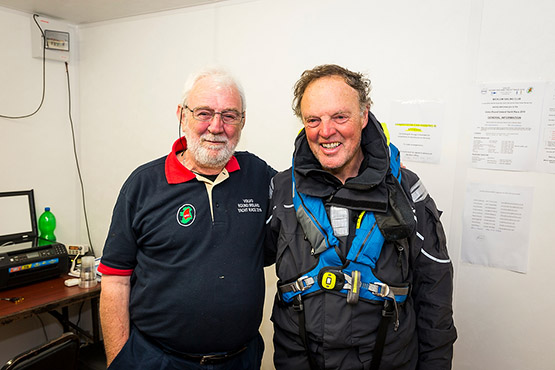
Midnight encounter. Race organiser Theo Phelan with RORC Commodore Michael Boyd after the latter had brought the First 44.7 Lisa across the Wicklow finish line to take third overall. Photo: David Branigan
But that third overall needed a bit of waiting, as the Class 3 front-runners of Euro Car Parks and Rockabill VI were still in with a chance, while Class 4’s GROUPE V and Stephen Quinn’s gallant little J/97 Lambay Rules were also in contention, but it was not to be. The minutes slipped away, the hours ticked by, and in the end over a course of 704 miles it was waterline length which counted as a fading breeze and much windward work saw the little ‘uns lose out. But my word, they had one impressive race amongst themselves.
The results are still being analysed as we write this, and it was only on the Friday that Rambler was finally confirmed as overall winner, with Teasing Machine second and Lisa Third. As for Class winners, they were (1) Teasing Machine, (2) Sarabande, (3) Euro Car Parks, and (4) GROUPE V, but GROUPE V lost her two-handed class lead to Begian Michael Kleinjans’ Open 40 Roaring Forty 2 which was another steady performer.
"All credit to Wicklow Sailing Club’s Theo Phelan and his team"
In all, it was a wonderful race, a magnificent sporting event from which any keen sailor can take much of interest and even more of entertainment and excitement. All credit to Wicklow Sailing Club’s Theo Phelan and his team who have kept this event going through the thin times, and have been ready and waiting to see it come to a new flowering with sponsorship from Volvo Car Ireland.
But all the background organization would have been meaningless without a fleet of boats and their crews game to take on the 704-mile circuit of an island set in an exposed location on the lee side of the Atlantic ocean, and in following this race it has been particularly encouraging to see the improving performances of certain boats as their relatively novice crews get to grips with the challenge they’ve taken on. Needless to say it was also a case of the Old Dog for the Long Road, and Ian Hickey’s Granada 38 Cavatina was again in the frame at the fiish in Class 4.

Top of the class - a notable performance by the sailing school crew from the INSS in Dun Laoghaire. Photo: Afloat.ie
Notably outstanding was the Irish National Sailing School’s Reflex 38 Lynx from Dun Laoghaire, skippered by Kenneth Rumball. She was always in competition, but as the race went on she seemed more in competition than ever, until at the finish she clocked in at fourth among all those hotshots in Class 3, close astern of Conor Fogerty’s Sunfast 3600 Bam at third, and placed tenth overall in fleet. The crew of Lynx have had one excellent lesson in offshore racing.

The essential post-race de-briefing – the crews of Euro Car Parks and Rockabill VI, leaders in Class 3, get together in Wicklow SC on Thursday afternoon after five days of racing against each other round Ireland. Photo: W M Nixon
Volvo Round Ireland 2016 selected results
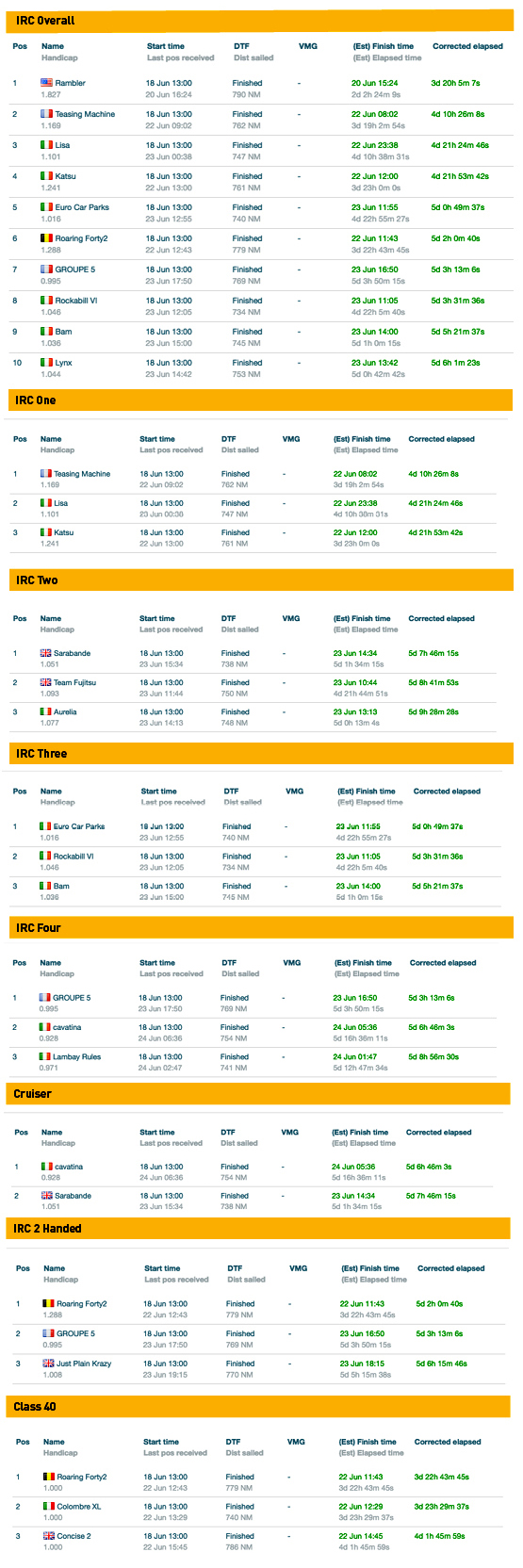
See Round Ireland tracker here Afloat's Round Ireland 2016 coverage is here and download overall results here
American businessman George David’s world-famous maxi yacht Rambler 88 completed a unique treble of Round Ireland wins this morning when he was officially declared the outright winner of the 2016 Volvo Round Ireland Yacht Race. On Monday, David also broke the monohull speed record and the race record too.
In what has been one of the toughest ever editions of the race, with rough seas resulting in 15 retirals from the record 63 strong-fleet, sailing history has been made across a series of fronts.
Last Monday George David smashed both the race record and the speed record for sailing around Ireland when the yacht crossed the Wicklow finish line after just 50 hours 24 minutes and 09 seconds.
However as the race is decided on handicap, it wasn’t until this morning (Friday 24th June) when the majority of the fleet had completed the 704 mile course around Ireland that the official result was certain.
His IRC handicap time was 3 days 20 hours and five minutes. Second place goes to Eric De Turckheim’s Teasing Machine and third place has been taken by RORC Commodore Michael Boyd aboard Lisa.
Race organisers have confirmed this has been the most exhilarating ever race in the Volvo Round Ireland’s 36 year history with a series of new race records and new world records smashed over the past week.
For the first time ever, multihulls were eligible to compete in the Race and three of the fastest and most-famous Mod 70’s from the US, Oman and the UK came to Wicklow with one aim – to break records – and all three did.
In a spectacular nail-biting contest, the three remained as little as half a mile apart for the entire course with Phaedo3 and Concise 10 looking likely to be first across the line right up to the end. In an astonishing change of fortunes, Oman Sail took advantage of an inshore track and pipped Phaedo to the post by six minutes, breaking their own 2015 record* by an incredible 2 hours, 14 minutes and 50 seconds. Concise 10 came in just over a minute later.
Beyond the competition aspect, this has been a very poignant and emotional event for many concerned.
The fact that it was George who set the new record was particularly meaningful as it was as a tribute to the Irish Rescue services who saved his life in 2011 that he took the decision to sign up for the race. He had two main objectives: first and foremost to grow the reputation of the race and attract other world-famous sailors to travel to Wicklow. The second was to break records – both targets were more than exceeded, but he hesitated to declare these intentions too soon, learning from his long and impressive business career that ‘actuals should exceed expectations.’
Indeed as he sprayed his crew with the winning Jeroboam of exclusive Italian Astoria prosecco, he reminded race organisers of his wise words.
It was also particularly nostalgic to see RORC commodore, Irish man Michael Boyd take the win for third place aboard First 44.7 Lisa. The 2016 Race marks the 20th anniversary of Boyd’s 1996 win with many of the same crew from his 1996 winning yacht, Big Ears.
Like George David, the RORC commodore, was determined to support Wicklow Sailing Club in growing the international profile of the prestigious race by participating himself.
These and many others came good on their promises and helped deliver a 63-strong fleet, the largest ever number of entries in the 36 year history of the race.
Race organisers at Wicklow Sailing Club say it has been an unforgettable week of sporting history.
Theo Phelan, Race organiser:
“The race is not over until every single yacht is back safe and sound across the finish line. There are still 4 boats at sea, which we expect in this afternoon. The reports from the sailors are that it was a fantastic race, with everything a race should contain. It started on Saturday afternoon and already by midday on Sunday, they were being hit full blast by 30 knot winds, leading to 11 retirals on Sunday alone.”
“The conditions were ideal for the fast yachts however - the Mod 70’s were outside the wind pattern of everybody else. The competition with the Mod 70’s was epic. As top Irish off-shore sailor Damian Foxall, who finished first aboard Oman Sail said, ‘if you really want to achieve good racing seed, you have to do it against other boats. The last boats are just as important as those which arrived in early. They have endured the greatest hardship and it is a tremendous feat that they have completed the 704 mile course’”
Race organisers have already confirmed a date for the next edition of the biennial race for June 30th 2018. Already some of the big names have declared their intention to return to contest their titles and new title sponsor Volvo has upped the ante by putting a brand new Volvo car up for grabs for the skipper who has accumulated the best overall points' results on corrected time, over a three-race series including this year’s edition.
This evening the tired but exhilarated sailors will attend the awards ceremony at Wicklow Sailing Club. The renowned sailors’ rum Goslings are putting on a special Goslings dark n’ stormy reception to welcome all the crews back.
See Round Ireland tracker here and keep to up to date with the fleet's progress with Afloat's regular Round Ireland 2016 updates here
The progress of George David’s Rambler 88 down the North Channel and the Irish Sea today has been remorseless, with the big silver boat ticking off waypoints like an express train closely on schedule writes W M Nixon. With the ebb tide helping her for the final stages, she was registered as crossing the finish line at 15-24-09, which means she has gone round Ireland in 2 days 2 hours 24 minutes and 9 seconds, which is one beautiful bit of sailing.
It means she has wiped out both the 2 days 17 hours race record of Mike Slade’s 100ft Leopard from 2008, and the open record of 2 days and 9 hours time set by Jean-Philippe Chomette’s CityJet/Solene in 2006. While the former had always been seen as eminently beatable, the latter was seen as pitching it a bit high. But with around 7 hours chopped off it, there’s just no questioning the quality of this showing.
The performance potential of the new generation of big canting keeled boats means everyone will have to re-configure their notions of what’s possible, as the fact that Rambler was beating virtually the whole way from Wicklow to the Fastnet Rock was comfortably offset by finding that once she’d freed sheets beyond the Fastnet, she was away like an express train.

Then too, the wind held up, and as the vid shot by Ryan Wilson off Larne at 0630 this morning shows, so long as it’s not verging on flat calm, Rambler 88 is capable of more-than-respectable speeds in modest breezes. But even so, the skills required to keep a boat of this calibre at peak performance are way beyond the imagination of most sailors. Yet from the moment Rambler 88 made that utterly brilliant start on Saturday, finding her way through a melee of confused smaller boats, we knew we were looking at something very exceptional.
But now, the south to west winds have been blowing for two days and more. And despite yesterday’s vile weather, it is still definitely June – indeed, tonight is the shortest night of the year. Thus the chances of prolonged periods of calm are increasing with every passing hour. All of which means that though the rest of the monohull fleet are still bustling along the west coast, the chances of them getting hung up by tidal gates and windless areas between Tory Island and Wicklow are growing all the time. Which in turn means that the chances of Rambler 88 taking the mighty mono-hull treble of a new record, line honours, and the overall win on IRC are increasing by the hour. Sailing history might well be in the making.
See Round Ireland tracker here and keep to up to date with the fleet's progress with Afloat's regular Round Ireland 2016 updates here
How to Make a Start in a Big Boat – Lessons 1 to 7
The nearer you were to today’s start of the Volvo Round Ireland Race 2016, the more amazing it all seemed. Yet it was difficult to see clearly what was happening as Teasing Machine and the mighty Rambler 88 came slicing through gaps which hadn’t even existed ten seconds earlier. Seen from a distance, it still looked both utterly marvellous – and totally scary. Photos: W M Nixon
See Round Ireland tracker here and keep to up to date with the fleet's progress with Afloat's regular Round Ireland 2016 updates here



























